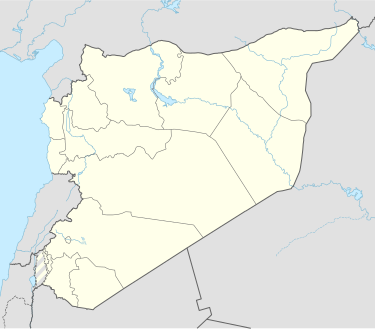Jerf el Ahmar (Arabic: الجرف الأحمر)[a] is a Neolithic site in northern Syria, which dated back between 9,500 and 8,700 BC.[1][2][3]
 Jerf el Ahmar located in the Fertile Crescent, circa 7500 BC | |
| Location | Syria |
|---|---|
| Region | Aleppo Governorate |
| Coordinates | 36°23′0″N 38°10′50″E / 36.38333°N 38.18056°E |
| Site notes | |
| Excavation dates | 1995–1999 |
| Archaeologists | Danielle Stordeur |
History
editJerf el Ahmar contained a sequence of round and rectangular buildings, which is currently flooded by the Lake Assad following the construction of the Tishrin Dam.[4] For five centuries, the site was shaped by the Mureybet culture, which had artifacts such as flint weapons and decorated small stones. The first transitions to agriculture in the region could be observed by the discovery of wild barley and einkorn.[5][6][7][8][9][10] The first evidence of lentil domestication appears in the early Neolithic at Jerf el Ahmar.[11]
Notes
edit- ^ Jerf el Ahmar means "red cliff".
References
edit- ^ Mithen, Steven J. (2006). After the Ice: A Global Human History, 20,000-5000 BC. Harvard University Press. ISBN 978-0-674-01999-7.
- ^ Hodder, Ian (2019-03-14). Violence and the Sacred in the Ancient Near East: Girardian Conversations at Çatalhöyük. Cambridge University Press. ISBN 978-1-108-47602-7.
- ^ Stordeur, Danielle (2019-11-28). Bibliographie (in French). CNRS Éditions. doi:10.4000/books.editionscnrs.27975. ISBN 978-2-271-08740-9.
- ^ del Olmo Lete, Gregorio; Montero Fenollós, Juan Luis, eds. (1999), Archaeology of the Upper Syrian Euphrates, the Tishrin Dam area: Proceedings of the International Symposium held at Barcelona, January 28th–30th, 1998, Barcelona: AUSA, ISBN 978-84-88810-43-4
- ^ George Willcox (2005). "The distribution, natural habitats and availability of wild cereals in relation to their domestication in the Near East: multiple events, multiple centres" (PDF). Vegetation History and Archaeobotany. 14 (4): 534–541. doi:10.1007/s00334-005-0075-x. Archived from the original (PDF) on 2022-12-21. Retrieved 2022-05-14.
- ^ Stordeur, Danielle (2019). Le village de Jerf el Ahmar (Syrie, 9500-8700 av. J.-C.): L'architecture, miroir d'une société néolithique complexe (in French). CNRS Éditions. ISBN 9782271130488.
- ^ Damania, Ardeshir B.; Qualset, Calvin O.; Harlan, Jack Rodney; McGuire, Patrick E.; Gepts, Paul; Bettinger, Robert L.; Brush, Stephen B.; Famula, Thomas R. (2012). Biodiversity in Agriculture: Domestication, Evolution, and Sustainability. Cambridge University Press. ISBN 9780521764599.
- ^ Demand, Nancy H. (2012-01-17). The Mediterranean Context of Early Greek History. John Wiley & Sons. ISBN 978-1-4051-5551-9.
- ^ Mithen, Steven J. (2006). After the Ice: A Global Human History, 20,000-5000 BC. Harvard University Press. ISBN 978-0-674-01999-7.
- ^ Potts, D. T. (2012-05-21). A Companion to the Archaeology of the Ancient Near East. John Wiley & Sons. ISBN 978-1-4051-8988-0.
- ^ Weiss, Ehud; Kislev, Mordechai E.; Hartmann, Anat (2006). "Autonomous Cultivation Before Domestication". Science. 312 (5780): 1608–1610. doi:10.1126/science.1127235. PMID 16778044. S2CID 83125044.

